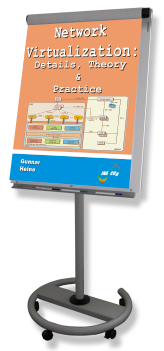 Network Virtualization: Details, Theory & Practice
Network Virtualization: Details, Theory & Practice
[2-day course, Euro 2,350.- (net) per participant]
 Training Course Description
Training Course Description
 This course addresses the needs of technical engineering staff within telecom carriers and equipment and software vendors who are involved in the design, setup and testing of virtualized telecom network equipment and software.
This course addresses the needs of technical engineering staff within telecom carriers and equipment and software vendors who are involved in the design, setup and testing of virtualized telecom network equipment and software.- Special focus of the course is on the ETSI ISG-based reference architecture which has been accepted by the industry as baseline.
- The course starts out with an introduction to NFV (Network Function Virtualization) and how it relates especially to SDN (Software Defined Networking).
- To emphasize the meaning of SDN for NFV, we establish during the course a live virtual network using Mininet and demonstrate basic SDN and OpenFlow operation with Wireshark.
- From there the course pinpoints to cloud computing and the related business models like IaaS, SaaS, PaaS and makes the student familiar with the ideas of NFVIaaS, VNFaaS and VNFPaaS.
- This part of the course concludes with an open discussion of the commercial and operational pros and cons of NFV.
- The following part of the course focuses on the detailed description of the ETSI-reference architecture and makes the students familiar with the different terms like MANO, NFVI and VNF, VIM VNFM and WIM.
- We explain in detail the configuration and setup of VNFs consisting of one or more VNFCs using differently configured virtual links. This part concludes with the detailed description of the instantiation of a VNF.
- The next part of the course is dedicated to MANO-descriptors like the VNFD, VLD, NFPD and VNFFGD that are crucial for the configuration, operation and interworking of the virtualized network equipment. We depict examples and explain their meaning and potential errors step by tstep which is so important for testing commissioning.
- The next lecture deals with the optimization and acceleration of virtualized environments and describes which means exist for that optimization like localized memory (NUMA) and multiple core operation. This part also deals with potential performance killers like interrupts and how to mitigate their impact.
- Finally, the course presents more NFV-scenarios like Scaling In/Out and Up/Down, behavior in case of VNF-outage and setup and collection of KPIs.
Some of your questions that will be answered
- How does NFV differentiate from SDN?
- What makes NFV so appealing for telecom operators?
- Which obstacles need to be overcome to use COTS-hardware in telecom networks?
- In which steps can NFV be introduced in which parts of the telecom network?
- Which hard- and software dependencies exist for virtualized network elements in terms of hypervisors and infrastructure?
- What are MANO-descriptors and what do I need to consider when I want to create, configure and on-board them?
- What are the tasks and functions of the different blocks inside the ETSI-reference architecture like VIM, VNFM and orchestrator?
 Pre-Requisites
Pre-Requisites
- The student must be familiar with basic virtualization concepts, telecom networks and their operation and administration.
- Experience with different operating systems, esp. UBUNTU and virtualized environments on a PC are beneficial.
 Training Course Target
Training Course Target
- The students are enabled to contribute during the setup, planning and testing of virtualized telecom networks.
- The students will be able to develop and interpret MANO-descriptors for VNFs etc.
 Training Course Duration
Training Course Duration
- 2 days
v1.00
ℹ️ Try out the updated search below!
Search:
More Info:
Detailed ToC of this training course
INACON eBooks
Please have a look at our full offer

